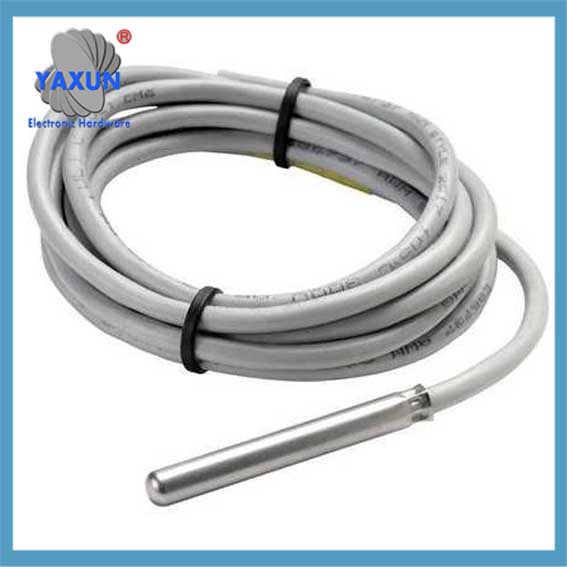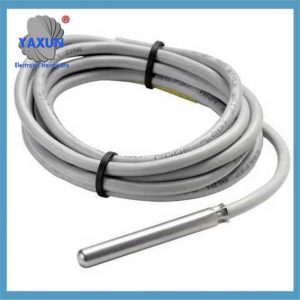Категории продуктов
- Тепловой выключатель 20
- Держатель блока предохранителей 36
- Датчик температуры 67
- Термовыключатель 64
- Автомобильный предохранитель 19
- Закрепить предохранители 7
- термопредохранитель 32
- предохранители для поверхностного монтажа 12
- термистор 22
- Держатель предохранителя для монтажа на печатной плате 27
- Жгут проводов 6
- Держатели лопастных предохранителей 17
- термостат 46
- Электрический предохранитель 14
Теги продукта
НТЦ, ПТК, ПТ100, DS18B20 для датчиков температуры
Зонд термопары: Он использует термоэлектрический эффект для измерения температуры., и имеет характеристики широкого диапазона измерений и быстрой скорости отклика..
Зонд термосопротивления: использует свойство изменения сопротивления металлов или полупроводников в зависимости от температуры для измерения температуры., и имеет характеристики высокой точности измерения и хорошей стабильности.
Полупроводниковый зонд: использует свойство изменения проводимости полупроводниковых материалов с температурой для измерения температуры., и имеет характеристики небольшого размера, легкий вес и низкое энергопотребление.
НТЦ, ПТК, ПТ100, DS18B20 Temperature probes and temperature sensors play an important role in the field of temperature measurement. The following is a detailed introduction to temperature probe sensors:
There are many types of temperature sensors, включая:
Термопары
These sensors are made of two dissimilar metals that connect at two points to form a junction. They are reliable, точный, and can operate over a wide range of temperatures.
Датчики температуры сопротивления (РДД)
These sensors are based on the change in resistance of a metal as the temperature changes.
Термисторы
These sensors use the temperature characteristics of semiconductor resistors, which change resistance as the temperature changes. Thermistors are sensitive and have high accuracy relative to their cost.
Отрицательный коэффициент температуры (НТЦ) термисторы
These sensors are sensitive and can respond to very small temperature changes. They have a temperature range of -50 ° C до 250 °С.
Resistive temperature detectors
These sensors have positive temperature coefficients (ПТК) and offer precise temperature measurements. Однако, they have poor sensitivity.
1. Definition and working principle
Temperature probe:
Definition: A temperature probe is a device specifically used to measure temperature, and its core component is a temperature-sensitive element.
Рабочий принцип: A temperature probe uses sensitive elements (such as thermocouples, thermal resistors, semiconductors, и т. д.) to convert temperature changes into electrical signals for subsequent circuit processing or display.
Temperature sensor:
Definition: A temperature sensor is a broader concept that includes a temperature probe and a signal processing circuit connected to it.
Рабочий принцип: A temperature sensor not only includes a sensitive element, but also has a signal processing circuit that can complete the acquisition, processing and output of temperature signals, usually in the form of digital or analog signals.
2. Types and characteristics
Temperature probe type:
Зонд термопары: Он использует термоэлектрический эффект для измерения температуры., и имеет характеристики широкого диапазона измерений и быстрой скорости отклика..
Зонд термосопротивления: использует свойство изменения сопротивления металлов или полупроводников в зависимости от температуры для измерения температуры., и имеет характеристики высокой точности измерения и хорошей стабильности.
Полупроводниковый зонд: использует свойство изменения проводимости полупроводниковых материалов с температурой для измерения температуры., и имеет характеристики небольшого размера, легкий вес и низкое энергопотребление.
Temperature sensor type:
Analog temperature sensor: outputs analog signals, which need to be converted into digital signals by analog-to-digital converters for subsequent processing.
Digital temperature sensor: directly outputs digital signals, обладает сильной противоположностью, высокая точность, and is easy to integrate into the control system.
Intelligent temperature sensor: has self-diagnosis, self-calibration, communication and other functions, and can realize remote monitoring and control.
3. Selection and application
Selection factors:
Application environment: Consider whether the measured environment has special conditions such as corrosiveness, high temperature, high pressure, и т. д., so as to select suitable materials and protection levels.
Measurement range: Select a suitable sensor according to the range of the temperature to be measured to ensure that the sensor can accurately measure within the required range.
Accuracy requirements: According to the accuracy requirements of the application for temperature measurement, select a sensor with corresponding accuracy.
Cost budget: Under the premise of ensuring performance, consider cost factors and choose cost-effective sensors.
Application areas:
Промышленная автоматизация: used to monitor temperature changes in industrial equipment, machines and production processes to ensure normal operation of equipment and product quality.
Medical industry: used in medical equipment, temperature monitoring instruments and drug storage equipment to monitor patient temperature, температура окружающей среды и условия хранения лекарств.
Automotive industry: used in electric vehicle motors, конденсаторы, Конвертеры DC, Системы зарядки, as well as automobile engines, коробки передач, air conditioning systems and exhaust systems to monitor and control the temperature of various liquids and gases.
Agriculture and food processing industry: used in agricultural greenhouses, cold storage, food processing equipment and transport vehicles to monitor and control the temperature of agricultural products and food.
Other fields: such as air conditioning and refrigeration industry, military and aerospace industry, Internet of Things industry, и т. д.. are also widely used.
IV. Использование и обслуживание
Installation: Install the sensor correctly according to the installation instructions to ensure good contact between the sensor and the object to be measured and avoid measurement errors caused by improper installation.
Wiring: Correctly connect the signal line and power line of the sensor to ensure the stability and accuracy of signal transmission.
Calibration: Calibrate the sensor regularly to ensure that its measurement accuracy meets the application requirements. The calibration process usually involves placing the sensor in a known temperature environment, comparing the difference between its output value and the standard value, and making necessary adjustments.
Maintenance: Clean and maintain the sensor regularly to avoid dust, dirt, и т. д.. that affect the measurement performance of the sensor. В то же время, pay attention to check whether the cable connection is loose or damaged, and replace damaged parts in time.
В итоге, temperature probe sensors have a wide range of applications and an important position in the field of temperature measurement. When selecting and using them, it is necessary to make comprehensive considerations based on the specific application scenarios and requirements to ensure the accuracy and reliability of the measurement results. If you have any other questions or need further help, please feel free to let me know.
Связаться с нами
Жду вашего письма, мы ответим вам в течение 12 часы с ценной информацией, которая вам нужна.
 English
English العربية
العربية Български
Български 粤语
粤语 中文(简体)
中文(简体) 中文(漢字)
中文(漢字) Nederlands
Nederlands Suomi
Suomi Français
Français Deutsch
Deutsch Ελληνικά
Ελληνικά Magyar
Magyar Italiano
Italiano 日本語
日本語 한국어
한국어 Polski
Polski Português
Português Română
Română Русский
Русский Slovenščina
Slovenščina Español
Español Svenska
Svenska ภาษาไทย
ภาษาไทย Türkçe
Türkçe Tiếng Việt
Tiếng Việt












